I'm really looking forward to hearing these 21 exciting presentations (and additional 30 posters) next December.
If you want to attend too, registration is open until October 17th through legend2025.sciencesconf.org
![Exploring the space of self-reproducing RNA using generative models, Martin Weigt
Exploring the archaic introgression landscape of admixed populations through
joint ancestry inference, Jazeps Medina Tretmanis [et al.]
Predicting natural variation in the yeast phenotypic landscape with machine
learning, Sakshi Khaiwal [et al.]
Phylodynamic modeling with unsupervised Bayesian neural networks, Marino
Gabriele [et al.]
Likelihood-free inference of phylogenetic tree posterior distributions, Luc Blas-
sel [et al.]
Generative continuous time model reveals epistatic signatures in protein evolu-
tion, Barrat-Charlaix Pierre
Neural posterior estimation for high-dimensional genomic data from complex pop-
ulation genetic models, Jiseon Min [et al.]
A differentiable model for detecting diversifying selection directly from alignments
in large-scale bacterial datasets, Leonie Lorenz [et al.]
Detecting interspecific positive selection using transformers, Charlotte West [et al.]
Predicting Multiple Sequence Alignment Uncertainty via Machine Learning, Lucia
Martin-Fernandez [et al.]
Graph Neural Networks for Likelihood-Free Inference in Diversification Mod-
els, Amélie Leroy [et al.]
Popformer: learning general signatures of genetic variation and natural selection
with a self-supervised transformer, Leon Zong [et al.]](https://cdn.bsky.app/img/feed_thumbnail/plain/did:plc:7x5c6ifrcznmg4mzhfuc2a6r/bafkreidur7bz43o2jhwr4gbt36awozawqthbkkfeszxjkxf4kvhyh7q6du@jpeg)
![PRIVET: PRIVacy metric based on Extreme value Theory, Antoine Szatkownik [et
al.]
Generative models for inferring the evolutionary history of the malaria vector
Anopheles gambiae, Amelia Eneli [et al.]
Language Models Outperform Supervised-Only Approaches for Conserved Ele-
ment Comprehension, Eyes Robson [et al.]
Identification and Classification of Orphan Genes, Spurious Orphan Genes, and
Conserved Genes from the human microbiome, Chen Chen
Neural Simulation-based inference of demography and selection, Francisco De
Borja Campuzano Jiménez [et al.]
Species Identification and aDNA Read Mapping Using k-mer Embeddings, Filip
Thor [et al.]
Contrastive Learning for Population Structure and Trait Prediction, Filip Thor [et
al.]
Protein and genomic language models chart a vast landscape of antiphage de-
fenses, Mordret Ernest
The Phylogenomics and Sparse Learning of Trait Innovations, Gaurav Diwan [et
al.]](https://cdn.bsky.app/img/feed_thumbnail/plain/did:plc:7x5c6ifrcznmg4mzhfuc2a6r/bafkreig4akadduemzbit67bv7jnr7x2ircwiriykabg2imuf3phy6hhube@jpeg)
I'm really looking forward to hearing these 21 exciting presentations (and additional 30 posters) next December.
If you want to attend too, registration is open until October 17th through legend2025.sciencesconf.org




Mark your calendars and make sure your best work is ready next September when the call for abstracts opens 🙂
legend2025.sciencesconf.org

Mark your calendars and make sure your best work is ready next September when the call for abstracts opens 🙂
legend2025.sciencesconf.org
@lblassel.bsky.social , assisted by P. Veber, Bastien Boussau
and myself.
The code and data are available at github.com/lucanest/Phy...
Please share if you find this interesting, and we welcome your feedback :)
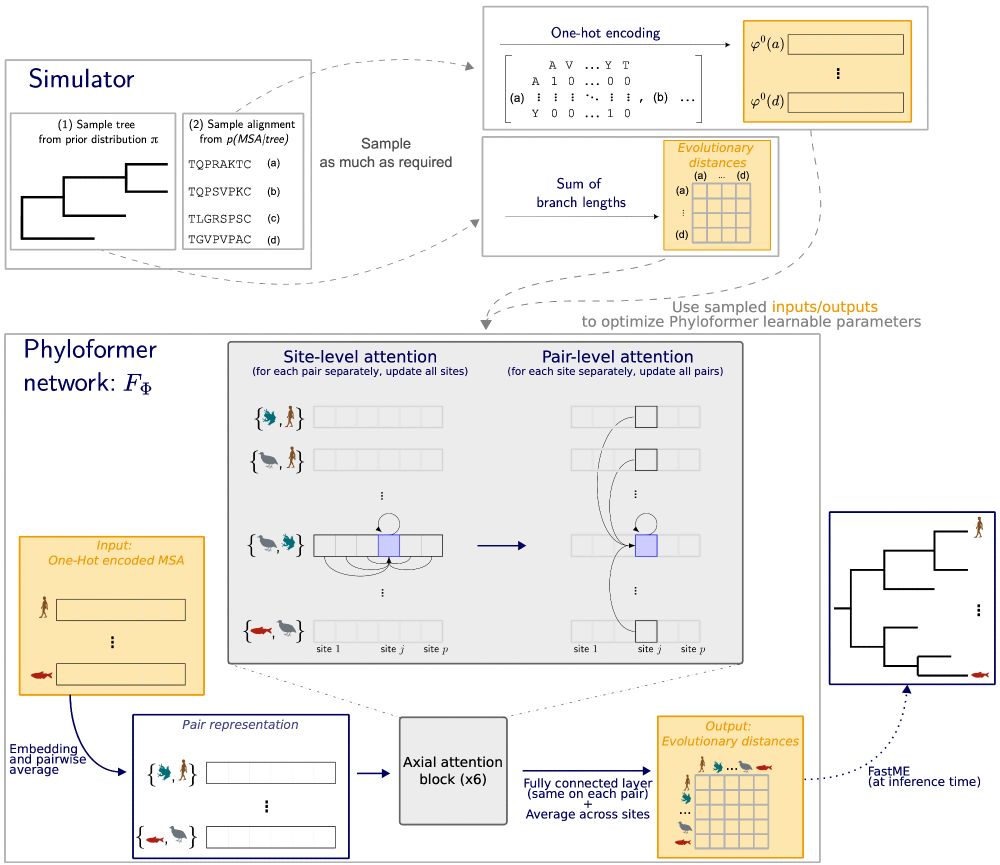
@lblassel.bsky.social , assisted by P. Veber, Bastien Boussau
and myself.
The code and data are available at github.com/lucanest/Phy...
Please share if you find this interesting, and we welcome your feedback :)
About two orders of magnitude faster than IQtree, and even twice faster than FastME.

About two orders of magnitude faster than IQtree, and even twice faster than FastME.
It outperformed all other methods, including IQTree/FastTree, on all metrics.
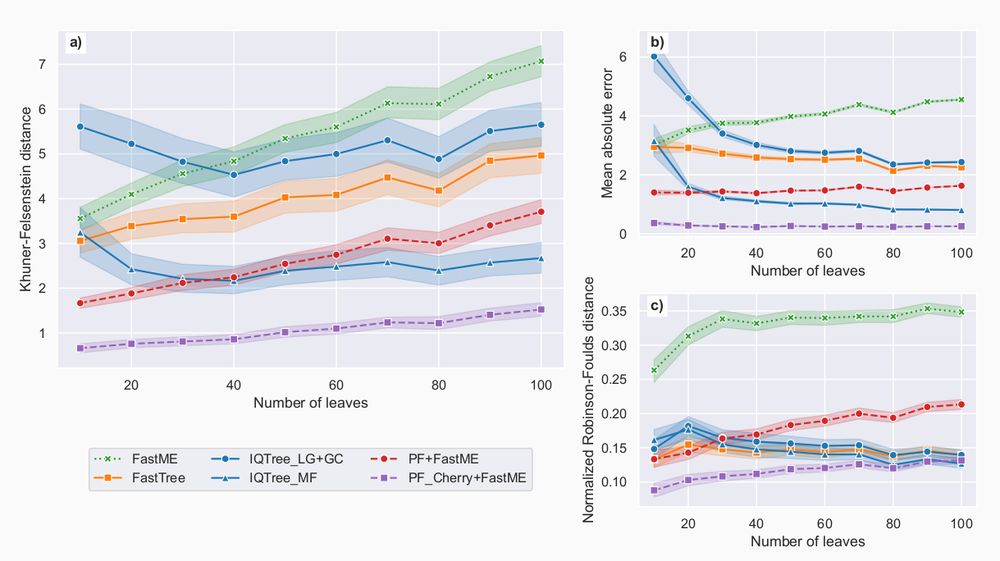
It outperformed all other methods, including IQTree/FastTree, on all metrics.
Looking at the topology only (Robinson-Foulds metric), it performed less well than IQTree/FastTree, but better than FastME.
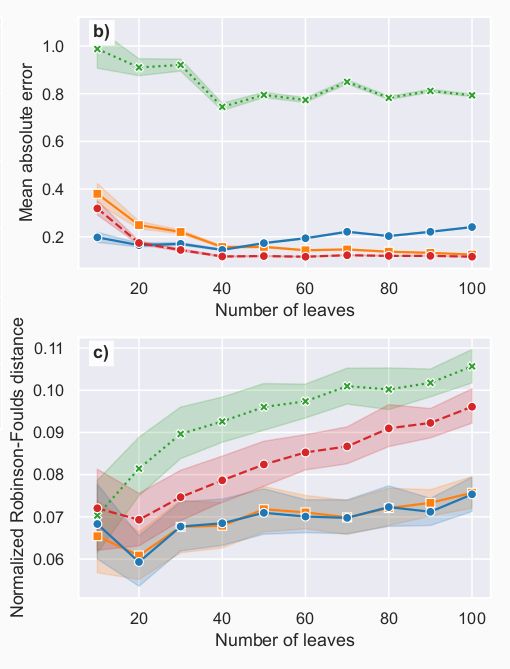
Looking at the topology only (Robinson-Foulds metric), it performed less well than IQTree/FastTree, but better than FastME.
It performed much better than FastME (distance method), on par with maximum likelihood approaches (IQTree, FastTree).
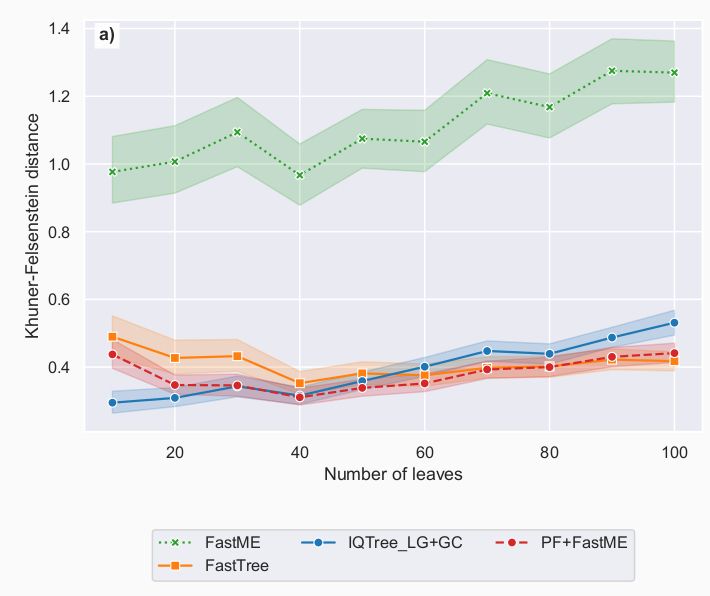
It performed much better than FastME (distance method), on par with maximum likelihood approaches (IQTree, FastTree).
This choice makes our function invariant to the order of the input sequences (any order yields the same output phylogeny).
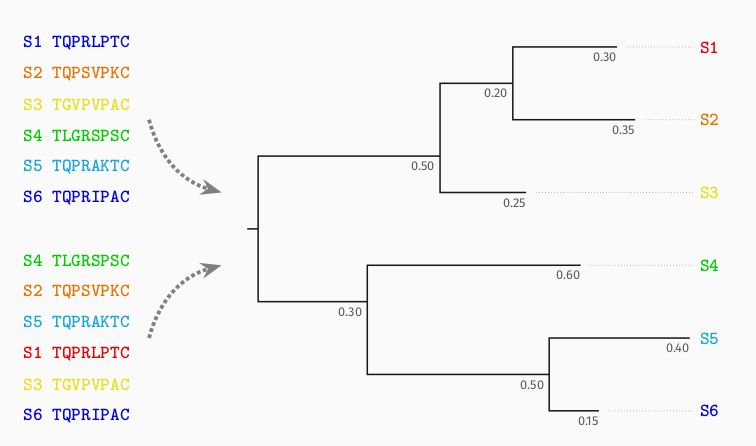
This choice makes our function invariant to the order of the input sequences (any order yields the same output phylogeny).
But each of these distance estimates is informed by the entire set of sequence, not just the corresponding pair!
We then pass them to FastME, a distance method, to obtain a tree.
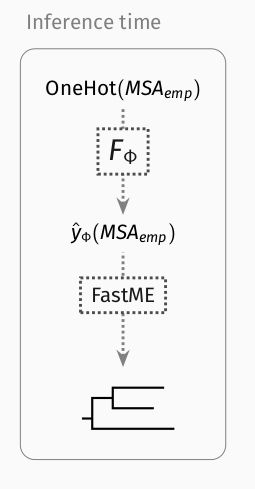
But each of these distance estimates is informed by the entire set of sequence, not just the corresponding pair!
We then pass them to FastME, a distance method, to obtain a tree.
We optimize this function on a large number of (phylogeny, sequences) sampled from the probabilistic model.
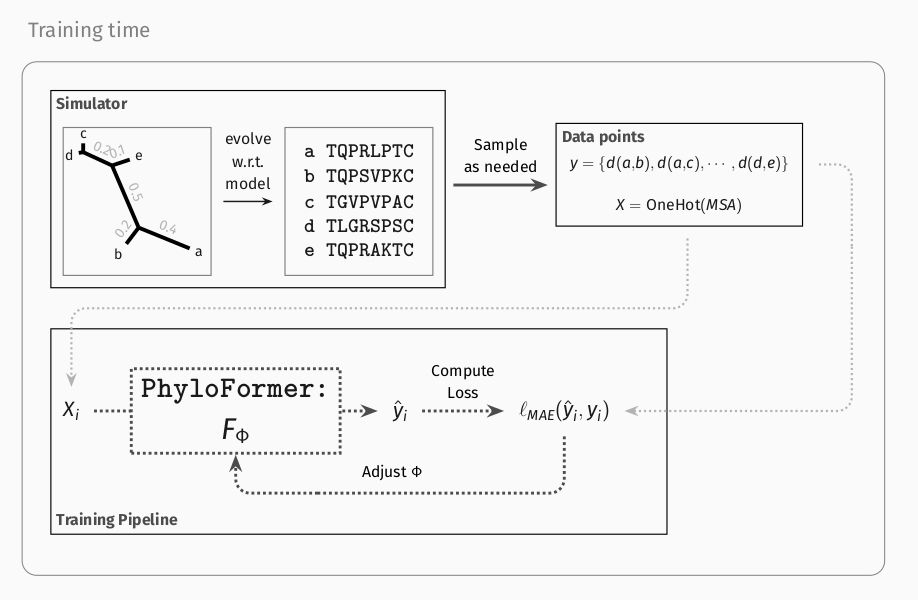
We optimize this function on a large number of (phylogeny, sequences) sampled from the probabilistic model.
Sampling trees and sequences under a probabilistic model is possible under much more complex models, for which likelihood computations would be prohibitive.
It's an alternative way to access the model.

Sampling trees and sequences under a probabilistic model is possible under much more complex models, for which likelihood computations would be prohibitive.
It's an alternative way to access the model.
This makes them accurate but slow. It also restricts these approaches to simplistic models under which likelihood computations are fast enough.
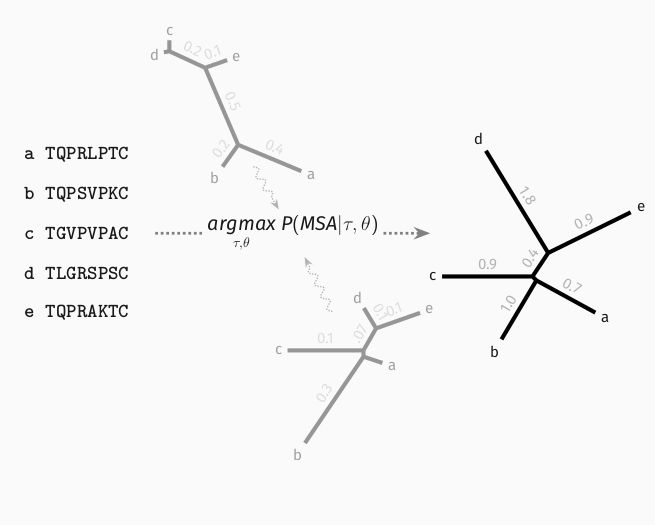
This makes them accurate but slow. It also restricts these approaches to simplistic models under which likelihood computations are fast enough.
Distance methods rely on this idea, with estimates from pairs of sequences taken separately. This makes them fast but inaccurate.
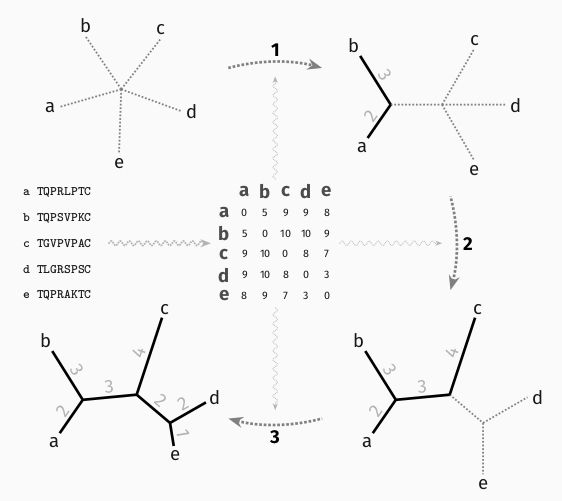
Distance methods rely on this idea, with estimates from pairs of sequences taken separately. This makes them fast but inaccurate.
In probabilistic models, branch lengths represent an expected number of substitutions between the sequences at the two ends.
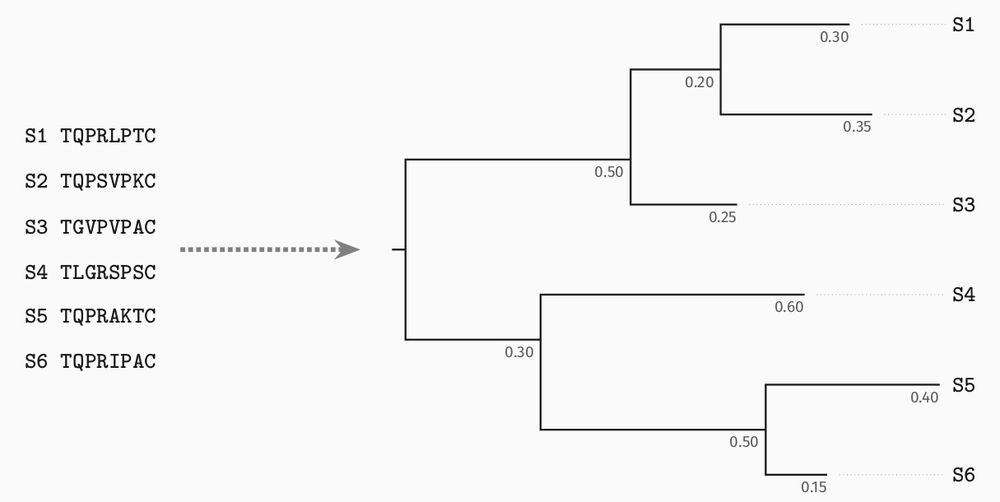
In probabilistic models, branch lengths represent an expected number of substitutions between the sequences at the two ends.
Faster than distance methods like neighbor joining, it outperforms maximum likelihood methods under complex models of sequence evolution.
🧵

Faster than distance methods like neighbor joining, it outperforms maximum likelihood methods under complex models of sequence evolution.
🧵

